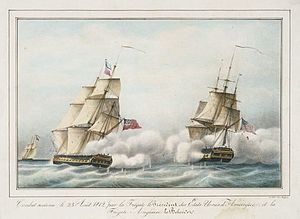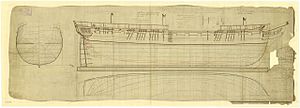HMS Belvidera (1809) facts for kids
class="infobox " style="float: right; clear: right; width: 315px; border-spacing: 2px; text-align: left; font-size: 90%;"
| colspan="2" style="text-align: center; font-size: 90%; line-height: 1.5em;" | 
|}
A plan of an Apollo-class frigatefrom 1803.
HMS Belvidera was a 36-gun frigate, a type of fast sailing warship, built for the Royal Navy in 1809. She was an important ship that fought in big conflicts like the Napoleonic Wars and the War of 1812. Belvidera had a long and active life at sea. Later, she served as a harbor ship and was finally sold in 1906.
Contents
| History | |
|---|---|
| Name | HMS Belvidera |
| Ordered | 28 September 1808 |
| Builder | Deptford Dockyard |
| Laid down | December 1808 |
| Launched | 23 December 1809 |
| Fate |
|
| General characteristics | |
| Type | Apollo-class fifth-rate frigate |
| Tons burthen | 94353⁄94 (as designed) |
| Length |
|
| Beam | 38 ft 2 in (11.63 m) |
| Draught | 13 ft 3 in (4.04 m) |
| Propulsion | Sail |
| Sail plan | Full-rigged ship |
| Complement | 264 |
| Armament |
|
Early Service and Adventures
Belvidera began her service in January 1800. Captain Charles Dashwood was her first commander. Soon after, Captain Richard Byron took over.
In July 1810, Belvidera and another ship, Nemesis, were sailing near Norway. They spotted three Danish gun-vessels in a large bay. The next day, seven boats from the British ships attacked.
Two of the Danish vessels were schooner-rigged, named Balder and Thor. Each had two large 24-pounder guns and six smaller 6-pounder guns. They also had a crew of 45 men. The third Danish vessel had one 24-pounder gun and 25 men.
The British captured Balder and Thor without any of their own crew getting hurt. The Danes, however, lost four men. The third Danish vessel escaped up a fiord, where its crew left it. The British then burned it.
In 1811, Belvidera became the main ship for Admiral Herbert Sawyer. She was stationed in Halifax, Nova Scotia, a key naval base.
Chasing American Ships
Belvidera was involved in one of the first battles of the War of 1812. This happened on June 23, 1812, just five days after the war started. She met three American frigates: USS President, USS Congress, and USS United States.
The British didn't know that war had been declared yet. After exchanging fire, Belvidera managed to escape during the night. Her actions helped a British convoy from Jamaica avoid being attacked by the American ships. Belvidera arrived safely in Halifax on June 27.
On July 16, 1812, Belvidera was part of a British group that chased USS Constitution. This was another strong American frigate. The winds were very light, so both sides used boats to tow their ships.
Constitution gained an advantage by using her anchors to pull herself forward. Captain Byron then copied this clever move. This brought the two ships close enough to fire at each other. They exchanged shots as a light breeze picked up. By daylight on July 19, Constitution was able to get away.
Capturing Enemy Ships
For the rest of the War of 1812, Belvidera was very busy. She helped blockade the American coast. This meant stopping American merchant ships and privateers (private ships allowed to attack enemy shipping). She captured many of them.
Between June and December 1812, Belvidera captured several merchant ships. These included the brig Malcolm carrying money and wine, and the ship Fortune with salt. She also captured the brig Minerva and the ship Oronoko with other British ships.
On August 21, Belvidera captured the American privateer schooner Bunker's Hill. This schooner had 7 guns and 72 men. Later, on September 10, she stopped a ship called Citizen. Two days after that, Belvidera captured the American schooner Hiram.
In January 1813, Belvidera recaptured a British mail ship called Nocton. An American ship, USS Essex, had captured Nocton earlier. Belvidera sent Nocton to Bermuda for repairs.
In February 1813, boats and men from Belvidera and other British ships attacked the American schooner Lottery. This ship was carrying coffee, sugar, and wood. The British captured Lottery, though six British men were wounded. The Americans had 19 wounded, and their captain later died. The British later used Lottery as their own ship, renaming her Canso.
Belvidera also helped capture the American ship St. Michael in February. In September 1813, she was with Statira and Morgiana when they captured Ambition.
On Christmas Day, Belvidera captured the schooner USS Vixen. Vixen was trying to get from Wilmington to Newcastle, Delaware. She had not yet received her guns when Belvidera captured her.
In March 1814, Belvidera, Endymion, and Rattler captured the American privateer Mars. Mars had 15 guns and 70 men. They later destroyed her. Belvidera also shared in capturing the brigs Christina and Massasoit.
On April 21, 1814, Belvidera captured the American ship New Zealander. This ship was carrying spermaceti oil. New Zealander was a prize captured by USS Essex and was almost back to New York when Belvidera captured her.
Belvidera also captured other American vessels. These included the schooner Nancy and Polly, and the sloops Alonzo and Hunter.
Later Years and Fate
After the war ended in 1814, Belvidera was taken out of service in Portsmouth. She was relaunched in September 1817 after being refitted. She then made many trips to the Mediterranean Sea, Portugal, Madeira, and the West Indies.
In 1834, she carried troops to St Kitts and then to Trinidad. In October 1846, Belvidera was changed into a store depot ship in Portsmouth.
An old record from August 23, 1847, mentions a Royal Marine from HMS Belvidera getting married in Tobermory Bay, Scotland.
Belvidera was refitted again between August and November 1852. She became a "receiving ship" in Portsmouth. This meant she was used as a place where new sailors could stay and be trained. She served in this role until 1890. Finally, she was sold on July 10, 1906, for £1,800.
Images for kids



